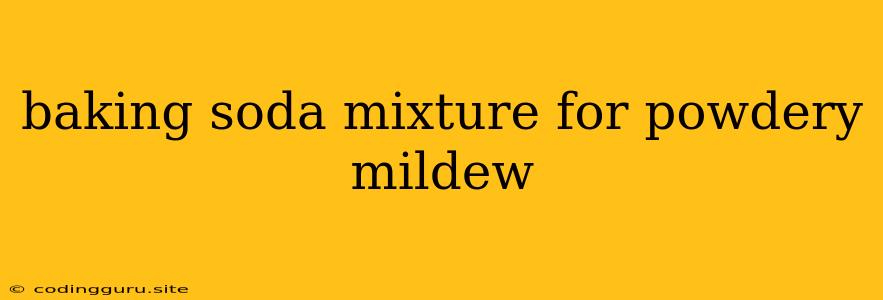Is Baking Soda Effective Against Powdery Mildew?
Powdery mildew is a common fungal disease that affects a wide range of plants, from vegetables and flowers to trees and shrubs. It appears as a white, powdery coating on leaves, stems, and fruits, and can cause significant damage if left untreated. While there are many commercially available fungicides to combat powdery mildew, many gardeners prefer to use natural, homemade solutions.
One such solution involves using baking soda, a common household ingredient. Baking soda (sodium bicarbonate) has been used for centuries as a cleaning agent, but it also possesses antifungal properties. Baking soda mixture can be effective in controlling powdery mildew by disrupting the fungal spores' growth and development.
How Does Baking Soda Mixture Work?
Baking soda mixture acts as a fungicide by creating an alkaline environment that is unfavorable for the growth of powdery mildew spores. The alkaline environment disrupts the fungal spores' ability to germinate and spread, effectively stopping the infection.
How to Make a Baking Soda Mixture for Powdery Mildew:
To create a baking soda mixture for powdery mildew, you will need:
- 1 tablespoon baking soda
- 1 gallon of water
- 1 teaspoon of horticultural oil (optional)
Instructions:
- Mix the baking soda and water thoroughly in a sprayer.
- Add the horticultural oil (optional). Horticultural oil helps to improve the mixture's effectiveness and prevent it from washing off the plant's leaves.
- Spray the affected plants thoroughly, ensuring all surfaces are covered.
- Repeat the application every 7-10 days, or as needed.
Note: Avoid spraying the baking soda mixture on hot days or when the sun is shining directly on the plants, as it can cause burning.
Tips for Using Baking Soda Mixture:
- Apply the baking soda mixture in the early morning or evening. This ensures that the mixture stays on the plants for longer and has more time to work.
- Use a fine-mist sprayer. This helps to ensure that the baking soda mixture is evenly distributed on the plant leaves.
- Avoid over-applying the mixture. Too much baking soda mixture can damage the plants.
- Always test the baking soda mixture on a small area of the plant first. This will help to ensure that it does not harm the plant.
Limitations of Baking Soda Mixture:
While baking soda mixture can be effective in controlling powdery mildew, it does have some limitations.
- It does not cure existing infections. It only prevents the fungal spores from spreading further.
- It may not be effective against severe infections. For severe cases of powdery mildew, you may need to use a stronger fungicide.
- It can damage some plants. Some plants, such as citrus trees, are sensitive to baking soda and may be damaged by the mixture.
Alternatives to Baking Soda Mixture:
There are other natural remedies that can be used to control powdery mildew, including:
- Neem oil: Neem oil is a natural insecticide and fungicide that is effective against a variety of pests and diseases.
- Milk: Diluted milk can be sprayed on plants to prevent and control powdery mildew.
- Potassium bicarbonate: Potassium bicarbonate is a similar fungicide to baking soda, but it is generally considered more effective.
Conclusion
Baking soda mixture can be an effective, natural solution for controlling powdery mildew on many plants. It is a safe and cost-effective method that can help to keep your garden healthy and free of disease. However, it is important to be aware of its limitations and use it with caution, especially on sensitive plants.
Remember, prevention is key. Maintaining good garden hygiene and providing optimal growing conditions for your plants can help to reduce the risk of powdery mildew.
